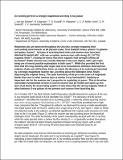Files in this item
An evolving jet from a strongly magnetized accreting X-ray pulsar
Item metadata
| dc.contributor.author | van den Eijnden, J. | |
| dc.contributor.author | Degenaar, N. | |
| dc.contributor.author | Russell, T. D. | |
| dc.contributor.author | Wijnands, R. | |
| dc.contributor.author | Miller-Jones, J. C. A. | |
| dc.contributor.author | Sivakoff, G. R. | |
| dc.contributor.author | Hernández Santisteban, J. V. | |
| dc.date.accessioned | 2019-09-11T09:30:02Z | |
| dc.date.available | 2019-09-11T09:30:02Z | |
| dc.date.issued | 2018-10-11 | |
| dc.identifier | 261035024 | |
| dc.identifier | a55e4e9d-a4f1-4a46-9562-8a8331eb42fd | |
| dc.identifier | 85054605504 | |
| dc.identifier.citation | van den Eijnden , J , Degenaar , N , Russell , T D , Wijnands , R , Miller-Jones , J C A , Sivakoff , G R & Hernández Santisteban , J V 2018 , ' An evolving jet from a strongly magnetized accreting X-ray pulsar ' , Nature , vol. 562 , no. 7726 , pp. 233-235 . https://doi.org/10.1038/s41586-018-0524-1 | en |
| dc.identifier.issn | 0028-0836 | |
| dc.identifier.other | BibCode: 2018Natur.562..233V | |
| dc.identifier.other | ORCID: /0000-0002-6733-5556/work/61370255 | |
| dc.identifier.uri | https://hdl.handle.net/10023/18456 | |
| dc.description.abstract | Relativistic jets are observed throughout the Universe and strongly affect their surrounding environments on a range of physical scales, from Galactic binary systems1 to galaxies and clusters of galaxies2. All types of accreting black hole and neutron star have been observed to launch jets3, with the exception of neutron stars with strong magnetic fields4,5 (higher than 1012 gauss), leading to the conclusion that their magnetic field strength inhibits jet formation6. However, radio emission recently detected from two such objects could have a jet origin, among other possible explanations7,8, indicating that this long-standing idea might need to be reconsidered. But definitive observational evidence of such jets is still lacking. Here we report observations of an evolving jet launched by a strongly magnetized neutron star accreting above the theoretical maximum rate given by the Eddington limit. The radio luminosity of the jet is two orders of magnitude fainter than those seen in other neutron stars with similar X-ray luminosities9, implying an important role for the properties of the neutron star in regulating jet power. Our result also shows that the strong magnetic fields of ultra-luminous X-ray pulsars do not prevent such sources from launching jets. | |
| dc.format.extent | 1029879 | |
| dc.language.iso | eng | |
| dc.relation.ispartof | Nature | en |
| dc.subject | QB Astronomy | en |
| dc.subject | QC Physics | en |
| dc.subject | DAS | en |
| dc.subject.lcc | QB | en |
| dc.subject.lcc | QC | en |
| dc.title | An evolving jet from a strongly magnetized accreting X-ray pulsar | en |
| dc.type | Journal article | en |
| dc.contributor.institution | University of St Andrews. School of Physics and Astronomy | en |
| dc.identifier.doi | https://doi.org/10.1038/s41586-018-0524-1 | |
| dc.description.status | Peer reviewed | en |
| dc.identifier.url | https://arxiv.org/abs/1809.10204 | en |
| dc.identifier.url | http://adsabs.harvard.edu/abs/2018Natur.562..233V | en |
This item appears in the following Collection(s)
Items in the St Andrews Research Repository are protected by copyright, with all rights reserved, unless otherwise indicated.

